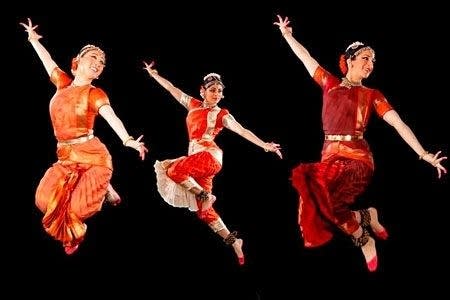Ragamala Dance earns rave review from NY Times

[image]
Ragamala Dance
The Minneapolis-based Ragamala Dance is in
New York
Create a More Connected Minnesota
MPR News is your trusted resource for the news you need. With your support, MPR News brings accessible, courageous journalism and authentic conversation to everyone - free of paywalls and barriers. Your gift makes a difference.
Washington D.C. for the Maximum India Festival at the John F. Kennedy Center. They performed Wednesday night, and New York Times critic Alastair Macaulay was in the audience.
Macauley saw four different companies perform over the course of three evenings, but it's obvious he was particularly smitted with Ragamala, to which he devoted the majority of his review. You can read the full review here, but I've isolated the section dealing with Ragamala below.
No sooner had either Ragamala Dance (an American company of the Indian Diaspora) ... begun, than every moment seemed precise, specific, focused. From those sharply defined beginnings arose complexities both rapturous and profound. The Ragamala musical instruments were actually an excellent example of fusion: for "Gangashtakam," the instruments included the mrindangam and nattuvangam and violin -- though producing sounds that most Westerners seldom associate with the violin.
"Gangashtakam" -- concerning the flow and worship of the river Ganga (Ganges) -- is a solo for Aparna Ramaswamy. Quickly she demonstrates just how many parts of the body are used in bharatanatyam (individual fingers, different parts of the sole of the foot, the spine tipped in many ways, eyes, head, arms and legs), the volumetric fullness with which a single dancer can become thrillingly three-dimensional, and the wide supply of rhythms and dynamic contrasts that enrich this form.
Every change of focus registers keenly. The swaying pliancy of the torso becomes deeply sensuous. (No dance form flatters the curves of the female torso more than that of India.) A simple, bouncing walk toward the audience and back is delivered with a subtlety that made it far from simple in its effect. Gestures ranging from small to large indicate the growth of the river, and their fluency its current.
But it is when it comes to meaning that we see differences between Indian and Western dance theater yet greater than those between Indian and Western music. In this solo about the Ganges, Ms. Ramaswamy seems now to embody the river, now to indicate it, now to worship it; and the forms of expression alternated between detailed mime gestures to the kinds of pure dance that seem as abstract and as impersonal as a human being can ever achieve. The dancer seems continually to move between different kinds of being and of thought, and the Western observer is aware of many layers of mystery.
In the second Ragamala dance, "Yathra" ("Journey"), five women dance to music for sitar and Indian cello. The work traces the course of a day and, by implication, a life. Dance themes are iterated by successive performers with different inflections. When, in the autumnal twilight-of-life solo near the end, we recognize some of the same material that had been shown in the brighter earlier section, the effect is movingly meditative. This is an excellent company; Ms. Ramaswamy is an enchantingly beautiful dancer.
...As with Ms. Ramaswamy, some of the most transporting instances are ones of near-stillness, when the dancer seems to be inhaling the moment as if it were incense.
Ragamala Dance next performs in the Twin Cities at the O'Shaughnessy Auditorium March 25-27.